PsychotoChem66
Harmless

Posts: 3
Registered: 4-4-2014
Member Is Offline
Mood: No Mood
|
|
Mystery Precipitate during Electrolysis of Water
So I recently decided to try the classic electrolysis of water experiment. I made two make shift electrodes from stainless steel wire and electrical
tape for insulation. I hooked up the electrodes to a 9V battery and set them underneath two test tubes to collect the evolving gases. I used a
solution of 7.5 grams of magnesium sulfate heptahydrate in about 250 mL of distilled water. After the electrodes were in place, within a minute, the
electrode at the positive terminal began to turn pink. Soon afterwards the pink colour leaked to the test tube above and eventually filled the entire
beaker. So firstly, why on earth did it turn pink? even more interestingly, a fluffy white precipitate began falling out of the test tube over the
anode and collecting at the bottom of the beaker. About an hour in the cell is still running and there is a substantial pile of white (maybe even a
little yellowish) precipitate at the bottom of the beaker. What is this precipitate. My best guess is that there is zinc in the stainless steel I am
using and a slat of zinc is being produced, zinc oxide? zinc hydroxide? zinc sulfate? i haven't a clue. If anyone knows what's going on here i would
appreciate your interpretation very much.
|
|
|
elementcollector1
International Hazard
    
Posts: 2684
Registered: 28-12-2011
Location: The Known Universe
Member Is Offline
Mood: Molten
|
|
Fluffy white stuff: Magnesium hydroxide, from the Mg (2+) ions and the (OH)- ions created from electrolysis. This is a common occurrence.
Pink stuff: Likely a mix of this and iron compounds, which are red to orange and can be created when iron is used as an anode.
Elements Collected:52/87
Latest Acquired: Cl
Next in Line: Nd
|
|
|
Steam
Hazard to Others
  
Posts: 238
Registered: 25-3-2014
Location: Minnesota
Member Is Offline
Mood: Triple Point
|
|
Sure you didn't have some Phenolphthalein in the testubes causing the solution to turn pink with the OH- ions in solution.
DISCLAIMER: The information in this post is provided for general informational purposes only and may not reflect the current law in your jurisdiction.
No information contained in this post should be construed as legal advice from the individual author, nor is it intended to be a substitute for legal
counsel on any subject matter. No reader of this post should act or refrain from acting on the basis of any information included in, or accessible
through, this post without seeking the appropriate legal or other professional advice on the particular facts and circumstances at issue from a lawyer
licensed in the recipient’s state, country or other appropriate licensing jurisdiction.
|
|
|
blogfast25
International Hazard
    
Posts: 10562
Registered: 3-2-2008
Location: Neverland
Member Is Offline
Mood: No Mood
|
|
Quote: Originally posted by Steam  | | Sure you didn't have some Phenolphthalein in the testubes causing the solution to turn pink with the OH- ions in solution. |
Exactly: I've had the same 'mystery' once. Phenolphtalein is unbelievably clingy to glass and the tiniest amounts give a pink colouration in alkaline
conditions.
|
|
|
Zyklon-A
International Hazard
    
Posts: 1547
Registered: 26-11-2013
Member Is Offline
Mood: Fluorine radical
|
|
Pink stuff is likely a Manganese compound. What kind of SS did you use?
Is zinc ever in SS? I haven't heard of that....
[Edited on 4-4-2014 by Zyklonb]
|
|
|
blogfast25
International Hazard
    
Posts: 10562
Registered: 3-2-2008
Location: Neverland
Member Is Offline
Mood: No Mood
|
|
Quote: Originally posted by Zyklonb  | Pink stuff is likely a Manganese compound. What kind of SS did you use?
Is zinc ever in SS? I haven't heard of that....
|
MnCl2 is only pink when it's almost pure. KMnO4 could be mistaken for pink at low, low concentrations but conditions here are unfavourable to form it.
|
|
|
aga
Forum Drunkard
    
Posts: 7030
Registered: 25-3-2014
Member Is Offline
|
|
Stainless Steel has Chromium in it, and traces of other stuff (e.g. Iron !)
Here's a composition breakdown for several types of stainless :-
http://www.yamco-yamashin.com/en/products/guide_stainless_st...
|
|
|
PsychotoChem66
Harmless

Posts: 3
Registered: 4-4-2014
Member Is Offline
Mood: No Mood
|
|
Thanks for all the responses guys!
Since yesterday there have been a couple of interesting developments. I let the reaction go to completion then removed the electrodes and test tubes
to leave a BRIGHT red/orange solution with a yellowish precipitate at the bottom. The solution did resemble phenolphthalein during the early stages.
But there are few reasons I do not believe that that's what is. 1. The solution is no longer pink but is more like red/orange, clearly whatever it is
appeared pink at lower concentrations and red/orange at higher concentrations. 2. When everything was finished reacting I tested the pH with pH paper
and found it to be 2-3, quite acidic indeed. Phenolphthalein would not keep its colour in acidic conditions.
I later filtered out the yellow solid and washed it wish dH2O and now im left a light brownish solid and the red solution. Still not sure what the
solid is, could be highly contaminated Mg(OH)2 but i have not tried to find out yet.
I believe the red solution is probably a result of either a chromium or iron salt, however I'm not sure how to go about finding out.
Should I neutralize (with what?) the solution and look for a precipitate, or should i just boil it down first to see if it is simply a water soluble
precipitate that will otherwise be destroyed with the addition of base?
Thanks again for your help fella's.
|
|
|
blogfast25
International Hazard
    
Posts: 10562
Registered: 3-2-2008
Location: Neverland
Member Is Offline
Mood: No Mood
|
|
If the solid contains iron (brown suggests iron hydroxide), then dissolve a little in strong HCl, If it turns light yellow and reacts positively with
KSCN, that's iron.
Re. the solution, not many Cr or Fe are red in solution. Try adding alkali and see what happens.
|
|
|
PsychotoChem66
Harmless

Posts: 3
Registered: 4-4-2014
Member Is Offline
Mood: No Mood
|
|
Quote: Originally posted by blogfast25  | If the solid contains iron (brown suggests iron hydroxide), then dissolve a little in strong HCl, If it turns light yellow and reacts positively with
KSCN, that's iron.
Re. the solution, not many Cr or Fe are red in solution. Try adding alkali and see what happens. |
Unfortunately I don't have HCl or KSCN at the moment but i have set aside the solid for further investigation at a later date.
As for the solution, I did in fact place a small amount in a test tube and mixed it with dilute NaOH. At first nothing seemed to happen except for a
cloudy white substance appearing momentarily upon mixing. After leaving it sit for 30 minutes, the solution became a faint green colour and there was
a fairly thick cloudy white layer settled at the bottom. I was unable to separate the two layers as they would just mix up immediately when i tried.
Any thoughts?
|
|
|
Artemus Gordon
Hazard to Others
  
Posts: 178
Registered: 1-8-2013
Member Is Offline
Mood: No Mood
|
|
I did this same experiment last night, with the only differences that I used 2.5 g MgSO4 heptahydrate/100 ml dH2O and I placed the 9v battery into the
reaction beaker. I also saw the fluffy white flakes fall out of the test tube over the anode and was curious about that, so I am glad to see that
explained.
In addition, I found that rather than a H2/O2 ratio of 2:1, I got more like 3:1. Wikipedia says formation of H2O2 can reduce O2 yield, but provided no
citation. So, is this true? I also noticed in the cathode tube a stream of what looked very much like the microbubbles of gas rising from the
electrodes, except they were FALLING. When they got close to the bottom of the tube, and thus close to the stream of O2 rising, they seemed to get
caught in the current and start rising again, so they seemed to have a density just slightly greater than the water/ MgSO4 solution. Could those have
been "bubbles" of H2O2?
[Edited on 6-3-2016 by Artemus Gordon]
|
|
|
aga
Forum Drunkard
    
Posts: 7030
Registered: 25-3-2014
Member Is Offline
|
|
Wooo !
Can you post a photo of the setup ?
Sounds like an experiment worth replicating.
[Edited on 6-3-2016 by aga]
|
|
|
Artemus Gordon
Hazard to Others
  
Posts: 178
Registered: 1-8-2013
Member Is Offline
Mood: No Mood
|
|
Quote: Originally posted by aga  | Wooo !
Can you post a photo of the setup ?
Sounds like an experiment worth replicating.
[Edited on 6-3-2016 by aga] |
I'm kind of a Luddite, but I do have a tablet with a camera, I will try to take some pics, but it might take me a few days.
In any case, it's a pretty simple setup: Two test tubes rubber-banded together with one of them clamped to a ringstand to suspend them both
upside-down over a 600 ml beaker. (Actually, I used two clamps, which makes it easier to work with one tube at a time, but I had to try several types
of clamps to find two which allowed the tubes to be held close enough together.) Fill the beaker with water/MgSO4 solution as I described above. (Not
too full, it's a good idea to have a second flask full of the sol. to top off the beaker after everything is submerged in it). Fill the test tubes
also (don't let any bubbles get it - I used a shallow bowl that I could submerge the tubes in sideways, then I used two (gloved) fingers on one hand
to hold the sol. in the tubes while I inverted them in the beaker. Then I taped a piece of thread to a 9v battery (the ones shaped like a little
rectangular block with both electrodes on the top). Tape the thread as close to the top as possible so the battery tilts as little a possible when you
lift it with the thread. This makes it easy to stand it on the bottom of the beaker without making a mess. Position the upside-down mouths of the test
tubes (still completely filled with liquid) over the electrodes. The big electrode is the negative one (anode) which Hydrogen will bubble off of, and
the little one is the positive cathode which will generate Oxygen. That's it!
One last, thing: If you don't have easy access to Epsom Salts, you can used baking soda instead (necessary to make the distilled water conductive to
electricity). DON'T try using NaCl! You would end up making Chlorine gas! Just a small amount probably, but you have to get your face very close to
the beaker to observe the reactions properly, and you don't want to be inhaling Chlorine.
|
|
|
Artemus Gordon
Hazard to Others
  
Posts: 178
Registered: 1-8-2013
Member Is Offline
Mood: No Mood
|
|
I had a few minutes last night to play around with taking some pics. This isn't the full electrolysis setup I described earlier. I hope to do that
this weekend.
This is a fun way to get a feel for how electrolytic cells work. I didn't add any salts to the distilled water in this case. I only added a few drops
of phenolphthalein indicator (0.05g phenolphthalein in 50ml EtOH and 50ml H2O), so the electrical current flow is limited by the self-ionization of
water. This sequence occurred over about 5-7 minutes. The phenolphthalein is reacting to the presence of OH- ions created near the anode as protons
from the water get reduced to Hydrogen gas. The OH- ions then migrate towards the cathode.
The camera doesn't capture the color and detail of the ion flow very well. This is much prettier to observe with your own eyes.
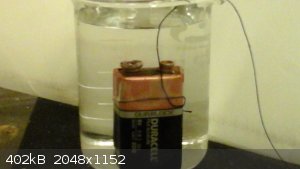 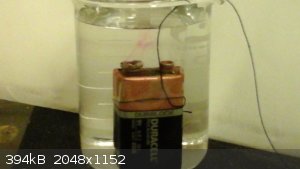 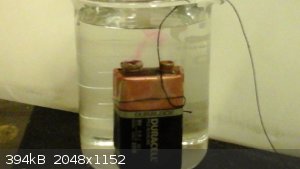 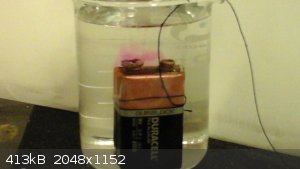 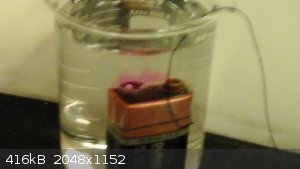
BTW, that black threadlike thing is exactly that - a piece of black thread I taped to the battery so I can easily pull it out of the water.
[Edited on 10-3-2016 by Artemus Gordon]
|
|
|